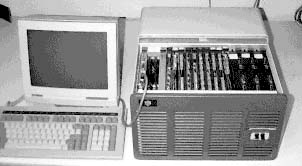Architecture
Figure 1: RCR System Design Overview

Over an Ethernet link in remote storage, the RCR system receives digitized images of an entire
mail piece, which have been scanned by a postal Multiline Optical Character
Reader (MLOCR) at a resolution of 212 pixels per inch (PPI), in a CCITT Group 3 compressed
format. The objective of the CEDAR RCR system is to encode the highest percentage of
mailpieces as possible at a sustained rate scalable to 5.6 mail pieces per second.
To reduce the processing requirement, the computationally intensive image analysis tasks in this
system were implemented to run on fast, specialized hardware. This hardware decompresses
the image, enhances image quality, and extracts a symbolic image representation of a
mail piece in less than 200ms. The resulting image representation is then presented
to a general purpose processor where software written in C programming language attempts to
encode the mail piece. Figure 1 outlines the functionality of the hybrid system.
Figure 2 illustrates the current CEDAR RCR that has been implemented.
After initially decompressing the input image, the image flow divides into two paths (see Figure
1): an enhanced image path and an unenhanced image path. The image enhancement operation attempts
to merge broken strokes in an effort to improve the quality of the input image.
Initially, the image is sent directly from the FAX decompression hardware and buffered in image
memory. Afterwards, the image in memory is sent to both the chain-code extraction
boards and the image enhancement hardware and then to two additional chain-code extraction boards.
In this way, the symbolic image representation for both the unenhanced (i.e. original) image and
the enhanced image are available to the general purpose processor.

Figure 2: RCR System Configuration

